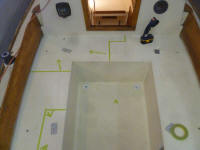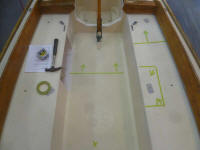
110 Cookson Lane | Whitefield, ME 04353 | 207-232-7600 | tim@lackeysailing.com
After some initial preparations and building staging around the forward end of the boat, I began the project with an overall deck inspection to determine the location and extent of the areas requiring repair. Known areas included sections of the cockpit, particularly in the cockpit seats where a series of holes had been drilled in the past for some unknown reason, on the cockpit sole around the rudder post, and on the starboard foredeck around the bow pulpit base.
Sounding the decks with a steel hammer revealed clear indications of damaged core over a large area of the foredeck encompassing the entire bow pulpit, a suspect area around the deck-stepped mast step, and the aforementioned sections of the cockpit. As I moved through the inspection, I demarked the questionable areas with tape.
The area on the foredeck was quite a bit larger than I'd anticipated, but otherwise the scope of repairs remained roughly as expected. After discussing the conditions with the owner, I continued the work by removing the bow pulpit and other deck hardware as needed in the areas to be repaired and/or repainted.
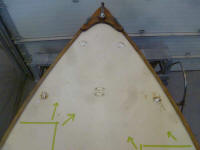
The repairs would be effected entirely within the existing nonskid pattern to avoid the additional work and expense of repainting the entire deck; only the nonskid would be repainted later. This meant that I had to keep my cutlines well within the nonskid to allow room for eventual fiberglass overlap onto the surrounding areas, so I marked off 3" in from the edge around the foredeck and applied masking tape to highlight the marks. Afterwards, I cut around the perimeter of the foredeck area with a saw; later I made additional cuts to ease the core removal process.
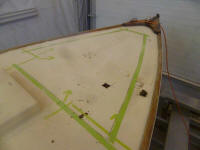
Next, I removed the old top skin and core beneath. Around the pulpit bases, as expected, the core was saturated and rotten, extending outwards several inches in all directions. The wetness continued towards the centerline, particularly at the after end, but as usual in between the damaged areas were sections of dry, sound core that was still well-adhered to the top and bottom deck skins. A longitudinal plywood beam down the centerline was damp, but I'd wait to make a determination on its ultimate fate.
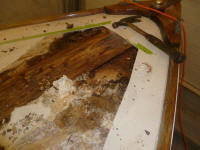
As I continued along the starboard side, I uncovered an unusual sight that gave me a taste for a Dixie Cup: at some point, someone had installed a pile of those little wooden ice cream paddles in this area of the deck. It was unclear how someone had accomplished this, as the top deck had clearly never been opened before, but in any event this loose pile of cheap wood and resin was someone's idea of a stopgap repair method. Quite amusing, but entirely ineffective. I carefully saved the pieces I removed for posterity, another brick in the foundation of my dream of a small museum of weird findings in old boats. (Later, I found additional ice cream paddles on the port side.)
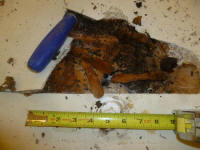
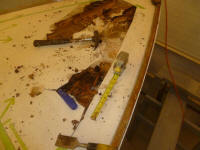
Eventually, I removed all the old core and top skin from the foredeck areas, leaving only the areas beneath the outer flanges to remove a little later. This brought me to the end of the day.
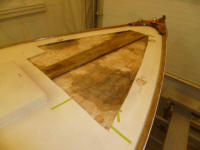
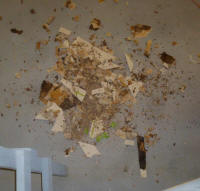
Total Time on This Job Today: 6.5 hours

